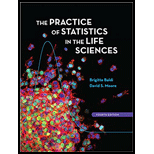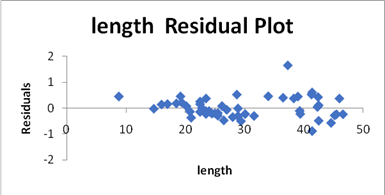
(a)
To plot the data and obtain the equation of the least squares regression line expressing width as a fraction of length.
(a)
Answer to Problem 25.13CRE
The regression equation is:
Explanation of Solution
In the question we have given the data in a table on the size of perch in a lake in Finland. Here we have to examine the relationship between width (y) and length (x) in perch. Thus, we have selected the data of the table and using excel we have constructed a

Here the length is on the horizontal line and width is on the vertical line. Thus, from this we can say that the relationship between width (y) and length (x) in perch is linear as the points are near to each other and positive in nature as they are moving in upward direction. Also, from the scatterplot, the equation of the least squares regression line expressing width as a fraction of length is as:
(b)
To find out how well can we predict the width of a perch from its length.
(b)
Explanation of Solution
In the question we have given the data in a table on the size of perch in a lake in Finland. Here we have to examine the relationship between width (y) and length (x) in perch. And, the equation of the least squares regression line expressing width as a fraction of length is as:
Since the
(c)
To predict the mean width of such fish and give a
(c)
Answer to Problem 25.13CRE
The mean of the width of fish is
Explanation of Solution
In the question we have given the data in a table on the size of perch in a lake in Finland. Here we have to examine the relationship between width (y) and length (x) in perch. And, the equation of the least squares regression line expressing width as a fraction of length is as:
It is given that the length of a typical perch is about
And the
| Coefficients | Standard Error | t Stat | P-value | Lower 95% | Upper 95% | |
| Intercept | -0.648744077 | 0.175139507 | -3.704156116 | 0.000500034 | -0.999877647 | -0.297610506 |
| length | 0.182225914 | 0.005642218 | 32.29685578 | 5.40028E-37 | 0.170913947 | 0.193537881 |
Thus, the confidence interval is:
(d)
To examine the residual and explain does fish number
(d)
Answer to Problem 25.13CRE
Yes, the fish number
Explanation of Solution
In the question we have given the data in a table on the size of perch in a lake in Finland. Here we have to examine the relationship between width (y) and length (x) in perch. And, the equation of the least squares regression line expressing width as a fraction of length is as:
For analyzing the residual, we will use excel. First go to the data tab and select the data analysis option. The dialogue box will appear and then select the regression from it click OK. Then another dialogue box will appear in which insert the data values and then the regression plot will appear as:

We can see from the residual plot that the points are near to each other but at the end they are more scattered and from this we can we that the fish number
Want to see more full solutions like this?
Chapter 25 Solutions
Practice of Statistics in the Life Sciences
 MATLAB: An Introduction with ApplicationsStatisticsISBN:9781119256830Author:Amos GilatPublisher:John Wiley & Sons Inc
MATLAB: An Introduction with ApplicationsStatisticsISBN:9781119256830Author:Amos GilatPublisher:John Wiley & Sons Inc Probability and Statistics for Engineering and th...StatisticsISBN:9781305251809Author:Jay L. DevorePublisher:Cengage Learning
Probability and Statistics for Engineering and th...StatisticsISBN:9781305251809Author:Jay L. DevorePublisher:Cengage Learning Statistics for The Behavioral Sciences (MindTap C...StatisticsISBN:9781305504912Author:Frederick J Gravetter, Larry B. WallnauPublisher:Cengage Learning
Statistics for The Behavioral Sciences (MindTap C...StatisticsISBN:9781305504912Author:Frederick J Gravetter, Larry B. WallnauPublisher:Cengage Learning Elementary Statistics: Picturing the World (7th E...StatisticsISBN:9780134683416Author:Ron Larson, Betsy FarberPublisher:PEARSON
Elementary Statistics: Picturing the World (7th E...StatisticsISBN:9780134683416Author:Ron Larson, Betsy FarberPublisher:PEARSON The Basic Practice of StatisticsStatisticsISBN:9781319042578Author:David S. Moore, William I. Notz, Michael A. FlignerPublisher:W. H. Freeman
The Basic Practice of StatisticsStatisticsISBN:9781319042578Author:David S. Moore, William I. Notz, Michael A. FlignerPublisher:W. H. Freeman Introduction to the Practice of StatisticsStatisticsISBN:9781319013387Author:David S. Moore, George P. McCabe, Bruce A. CraigPublisher:W. H. Freeman
Introduction to the Practice of StatisticsStatisticsISBN:9781319013387Author:David S. Moore, George P. McCabe, Bruce A. CraigPublisher:W. H. Freeman





